Satellite Imagery for Emergency Management
- Zuzana Hajkova, Content Marketing Coordinator, EUSI
The use of satellite imagery for emergency response and management is invaluable. Both optical and SAR images help rescuers save lives when disasters happen, assist with damage assessments, and in many cases contribute to successfully preventing and predicting emergencies. Which events can be prevented? How exactly do first responders use satellite images? When are they better than other methods? We have summarised our 20+ years of experience in this article.
- First, we’ll have a look at how satellite imagery helps in different stages of a disaster event (before, during, and after).
- Then, we’ll discuss the benefits of satellite images compared to other methods – rapid delivery, very high resolution, the ability to collect large areas, and more.
- We’ll show you real-life examples of different natural disasters that happened during the past few years.
- Last but not least, we’ll introduce the Copernicus EMS – an EU initiative providing free emergency mapping services.
- At the end of the article, you’ll find a summary of the key takeaways in bullet points.
Table of Contents
“Since 2002, we have been part of emergency response services in Europe. In the last ten years, we have delivered 1,300+ orders with 230,000+ square kilometres to programmes and organisations in the field of emergency response like Copernicus EMS, UNOSAT, EMSA, or the German Centre for Satellite Based Crisis Information. Thanks to this, we have extensive experience in remote sensing for emergency management.”
Henning Götz, Project Manager at EUSI
How are satellite images used in emergency response?
Remote sensing plays an important role in the whole cycle of managing an emergency event: before, during and after. Let’s look at all stages of a disaster, from prevention to damage analysis and reconstruction monitoring.

Timeline of using satellite images for emergency management.
1. Predict and prevent
If you understand the risks, you can predict certain types of disasters. For example, satellite imagery plays an important role in flood risk management and predictions. You can use multispectral images to conduct soil analysis, which reveals valuable information about soil moisture, soil texture, and other soil properties that influence water infiltration and runoff. 3D models created from satellite imagery can be used to analyse the terrain and assess which areas are at risk of flooding.
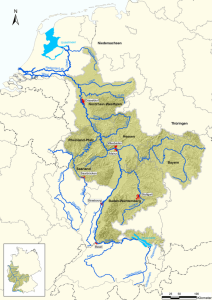
A digital terrain model can be used to determine the catchment areas of rivers. If a certain amount of precipitation falls within these areas, you can effectively assess flood risks and implement preventive measures. Source of the image: FFG Rhein, Map © LfU RP
In 2022, researchers carried out a study which confirmed that the combination of satellite imagery and in-situ data can be used to predict landslides. How? Satellite images reveal steep and open erosion areas, as well as the vitality of vegetation and soil moisture which are factors influencing the occurrence of landslides. Read more about this study in a separate article.
Last but not least, in forestry, satellite images are used to assess and mitigate the risk of wildfires. These are some of the ways to identify high risk areas:
- Analyse the vitality of vegetation.
- Map vegetation density.
- Identify areas of deadwood, for example due to bark beetle attack, as these are at a higher risk of fire.
2. Plan and be prepared
You can’t accurately predict and prevent all disasters… but you can be prepared. In case an emergency occurs, you will be able to save lives.
Satellite images and 3D models are valuable tools for planning evacuation routes. For example, in 2016, Brazilian security officials used VHR imagery from the Maxar satellite constellation to map Rio De Janeiro and plan for every possible contingency before the Olympic Games. They were able to map, with incredible detail, areas of increased risk to public safety, mosquito infested neighbourhoods, possible security breaches for VIP visitors and escape routes in the event of emergencies. They even used the most advanced Digital Surface Models (DSM) to evaluate the “Line of Sight” between key areas throughout the event.
- We have partnered with GAF AG to deliver DSMs in as little as 24 hours after image collection so that you can get to work immediately. Find out more about Rapid DEM.
3. During the emergency
When natural disasters or other emergencies strike, it’s crucial to rapidly collect and downlink imagery from the area. Relief organisations use these images to create maps, plan the allocation of relief resources, consider the status of critical infrastructure, choose suitable evacuation routes, and help the efficient deployment of disaster response teams.
Using satellite images during emergencies can help answer questions such as:
- How many disaster responders are needed in each area?
- Which evacuation routes are currently obstructed?
- Is this location suitable for a helicopter landing?
- Is a wildfire still active?
- How many people need to be evacuated?
- Where can we establish temporary medical facilities?
- In which direction is the fire progressing?
- Is there a hazardous material spill that needs to be contained?
- Which areas are safe for setting up base camps?
- Are there any disruptions to water supply systems?
- Were power lines damaged?
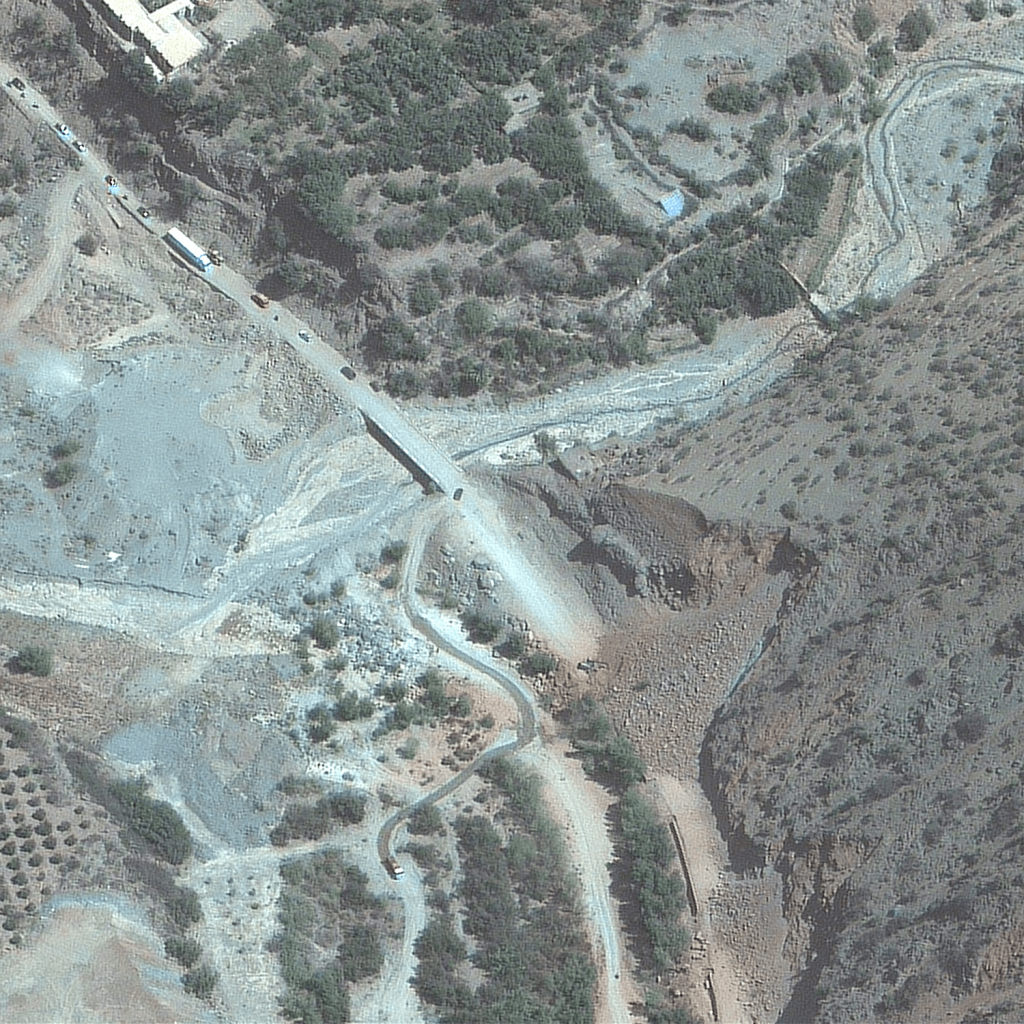
This satellite image shows that an evacuation route was blocked after an earthquake. Thanks to this, rescuers know which roads can be used for evacuation. | Satellite imagery © 2024 Maxar Technologies Provided by European Space Imaging
But what about clouds?
Many natural disasters – floods, hurricanes, wildfires, or volcano eruptions – are accompanied by clouds or smoke. This is when SAR imagery becomes invaluable. Synthetic Aperture Radar can penetrate cloud cover and smoke, and provide clear, high-resolution images of the area.
For example, in June 2024, we worked closely with the DLR-ZKI (Centre for Satellite Based Crisis Information at the German Aerospace Centre) to rapidly collect and deliver both optical and SAR satellite images of floods in Southern Germany. Analysts from the IFAS (Indicator Monitoring for Early Acquisition of Innovative Satellite Sensors in Natural Disasters) project received the imagery and created maps detailing flooded areas. The results were immediately made available to authorities and relief organisations such as the Bavarian Red Cross (BRK) and the German Federal Agency for Technical Relief (THW).
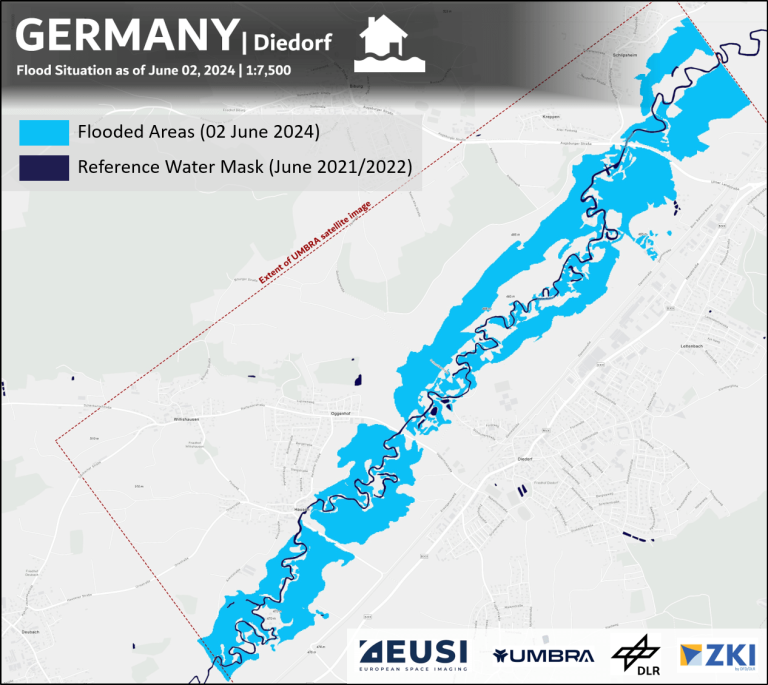
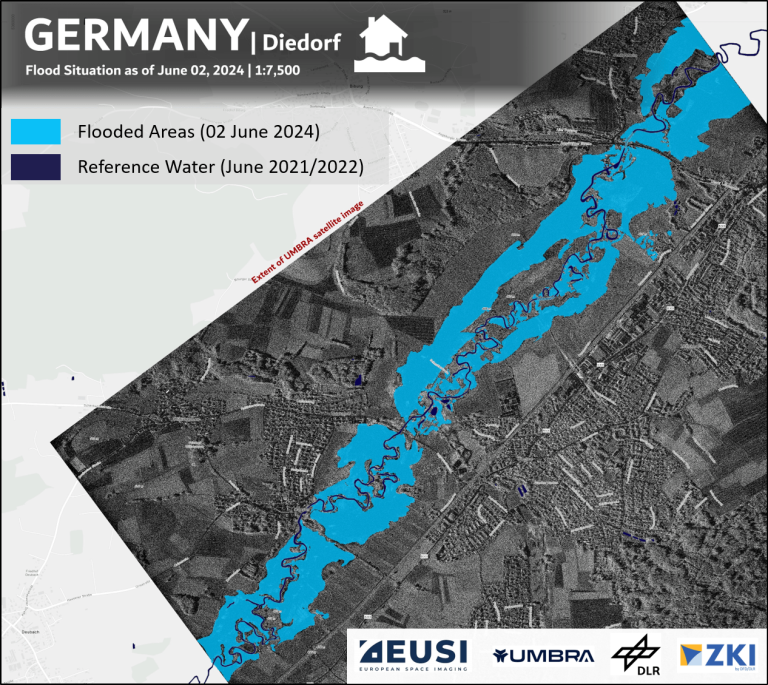
4. After the emergency: damage assessment
If you surveyed large areas devastated by natural disasters, it would take days. That’s why analysts often use satellite images to assess the extent and magnitude of damage and create damage maps. In the image below, you can see an example of damage analysis by ZKI at DLR.
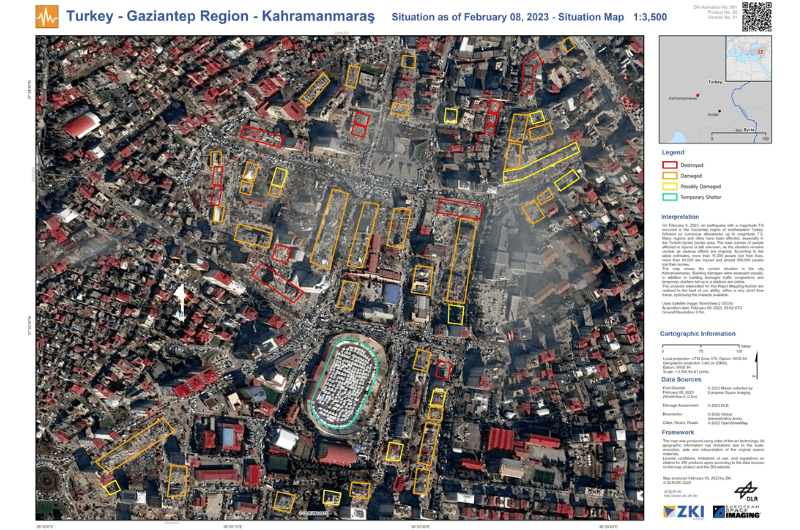
Damage after the earthquake in Kahramanmaras, Turkey in 2023. The analysis was created by ZKI at German Aerospace Centre (DLR). | Satellite imagery © 2024 Maxar Technologies Provided by European Space Imaging
With access to a satellite imagery archive, it’s easy to compare images of the area from before and after the event, which helps emergency management organisations quickly understand the effect of the emergency and its impact on the environment. Our archive includes images dating back to 1997.
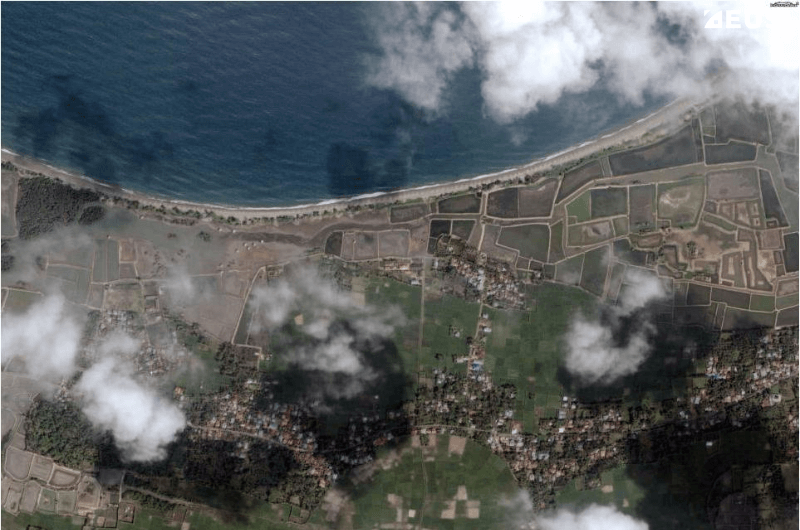
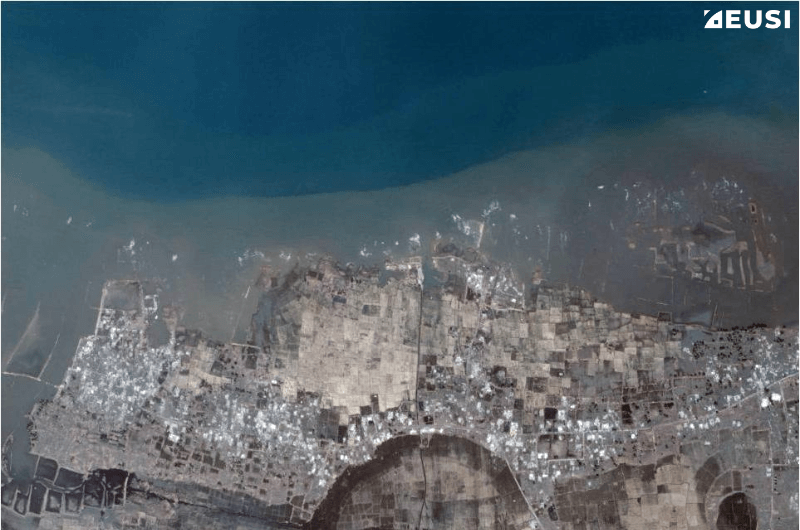
View of a coast in Japan hit by a tsunami – before and after the event. | Satellite imagery © 2024 Maxar Technologies Provided by European Space Imaging
5. Monitoring reconstruction
After the extent of damage is clear, satellite images can be used to monitor reconstruction – like after the explosion in the port of Beirut in 2020. A large amount of ammonium nitrate stored in a warehouse exploded, and damage affected large areas reaching kilometres inland. Authorities used satellite imagery to assess the damage and subsequently monitor the reconstruction progress on a quarterly basis. The goal was to evaluate the reconstruction status of buildings and critical infrastructures, assess the changes in landfills and waste areas, and guide the reconstruction project.
- Area of Interest size: 84.41 km2
- Off Nadir Angle: a combination of <15° to see the reconstruction status of buildings and 28°–43° to see details such as the sides of the buildings, cranes, or debris next to buildings
However, despite the many advantages, this application also has several limitations. Especially in dense urban landscapes with high buildings and narrow streets, visibility may be reduced, small-scale damage is hard to recognise, and analysing damage inside buildings is not possible. A combination of remote sensing with other methods, such as field surveys, is therefore ideal.
“The use of satellite based visual analysis is an efficient and cost-minimising possibility to analyse large areas in a repeating manner. It might be the only suitable possibility in case of areas being too remote or closed for certain reasons.”
Copernicus
The benefits of using satellite imagery for emergency response
Satellites are able to quickly capture and deliver very high resolution images over large areas, with no terrain restrictions. Moreover, they can provide additional information that human eyes can’t see, and in some cases penetrate clouds and smoke.
Rapid delivery
To take action and save lives, you need information as quickly as possible. And satellites are much faster than any other method. They can collect vast areas within minutes, and then deliver the data to you in a short amount of time. To make this process even faster, EUSI has invested millions of Euros into their ground station at the German Aerospace Center (DLR) in Munich, and is now able to deliver imagery as quickly as up to 15 minutes after collection.
Very high resolution
Not only the speed but also the quality of the data is pivotal. Low-resolution imagery, such as from the Sentinel constellation, can provide a quick, rough overview of the situation. However, in very high resolution (VHR) satellite images at a resolution of 30–50 cm, you can see details like individual plants, power lines or vehicles. 30 cm is currently the highest commercially available resolution of optical imagery; however, there are two more options to gain even more visual clarity:
- The native resolution of 30 cm can be enhanced to 15 cm HD – this is done through Maxar’s proprietary imagery enhancement algorithm.
- SAR imagery can provide very high resolution too. For example, Umbra offers SAR imagery at 25 cm resolution.
Easy access to all areas
Another major benefit of satellite imagery is that it can easily access all areas, regardless of the terrain. This is particularly important for remote areas of interest, in mountainous regions, or in areas that are difficult to access due to the disaster.
Large-scale collections
The ability of satellites to collect images over large areas is crucial for emergencies; wildfires, floods, and other natural disasters can affect hundreds of square kilometres. The average size of an image we collect over an area affected by a disaster is 550 km2.
How big is the area that a satellite can collect in a single image?
- Maxar WorldView-2 satellite: 15,000 km2
- Maxar WorldView-3 satellite: 7,000 km2
- Maxar GeoEye-1 satellite: 5,000 km2
Moreover, the large-scale collection brings homogenous data. You don’t have to stitch together images collected at different times, with different angles and in different weather conditions, like it is with aerial or drone imagery.
8 multispectral bands
There are countless applications using multispectral imagery to see beyond the capabilities of the human eye – one of them is wildfire monitoring. EUSI is the only satellite imagery provider in Europe that is able to collect imagery with 8 multispectral bands at 30 cm resolution (after pansharpening), or with 8 short-wave infrared (SWIR) bands at 3.7 m resolution. The distinct advantage of 8 bands (Coastal, Blue, Green, Yellow, Red, Red Edge, NIR1 and NIR2) is that not only can the user see burnt vs healthy vegetation, but also by utilising the longer wavelengths of the near-infrared (NIR) spectrum, you are able to penetrate haze, light fog, smoke and other atmospheric conditions better, which allows you to spot and analyse features on the ground. This can give firefighters and emergency responders deeper insights into potentially open roads and the exact locations of the flames.
In July 2023, we collected 8-band imagery of the wildfires in Greece. See the comparison of the same image collected as true colour, false colour with 4 bands, vs false colour with 8 bands:
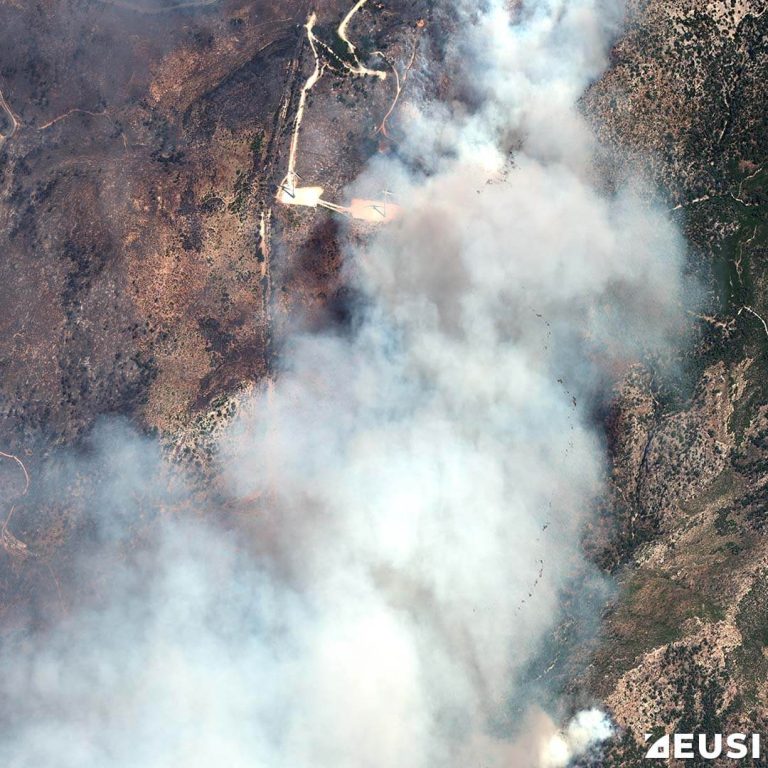
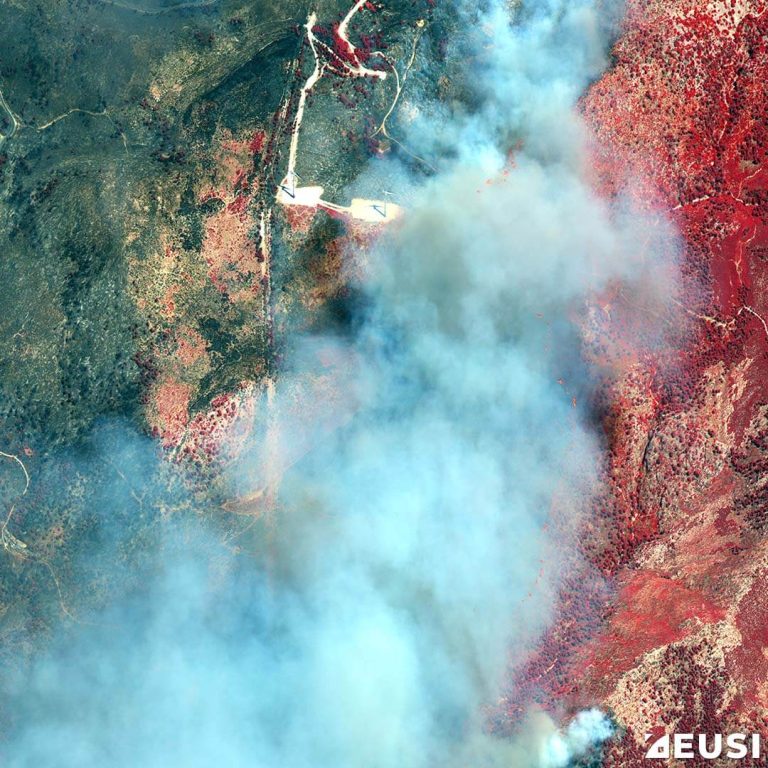
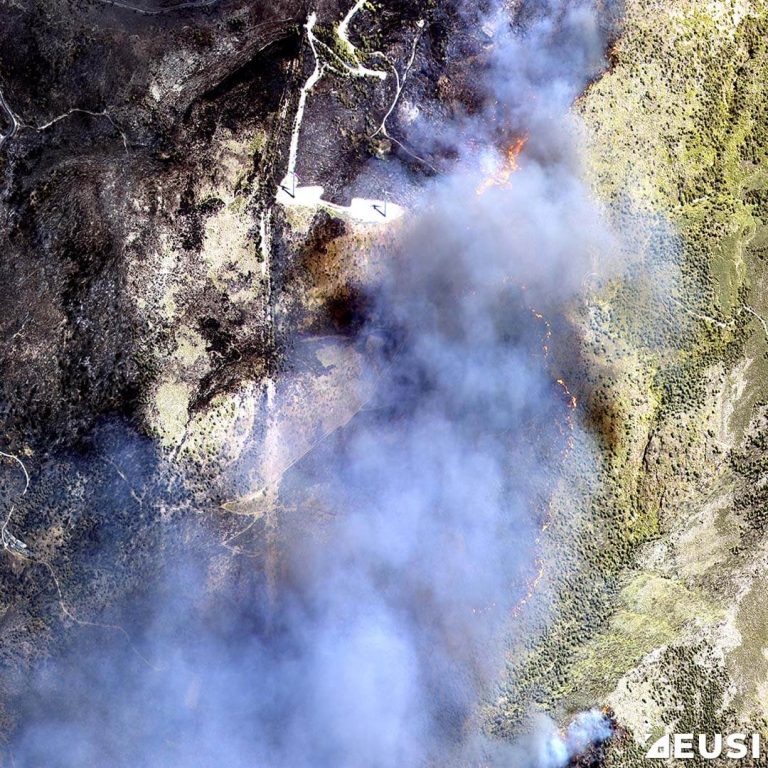
Seeing through the clouds
While 8-band imagery can penetrate smoke and clouds to a certain degree, SAR imagery can penetrate it completely. It’s therefore a valuable tool for monitoring emergencies in unfavourable conditions, such as cloud coverage, smoke or fog. Where aircraft or drones would see nothing, or it would even be dangerous to send them to the area, Synthetic Aperture Radar can safely collect a clear, high resolution image of the whole scene.
Floods
According to the International Disaster Database, in 2023 alone, flooding affected 1.6 million people in Europe and caused around 81% of the year’s economic losses due to weather and climate-related events on the continent. Authorities and organisations are facing pressure to respond quickly and efficiently, which requires state-of-the-art data and technology – including VHR satellite imagery.
During or shortly after rainfall, emergency responders usually task SAR satellite missions, which are able to penetrate clouds and provide high-resolution imagery despite the cloud cover. This allows responders to quickly create maps and effectively allocate resources. Later, when atmospheric conditions improve, optical images are collected. This allows for deeper damage assessment and provides necessary data for informed decision making.
It’s also possible to task a DoubleShot – a collection of both optical and SAR imagery only a short time apart. Weather can change quickly, and so does the cloud-dependent ability to capture optical imagery. With DoubleShot, we will task both optical and SAR satellites so that you always receive usable data, no matter the atmospheric conditions.
Floods in Southern Germany 2024
In June 2024, when devastating floods struck Southern Germany and multiple people were declared dead and several missing, we worked closely with the DLR-ZKI (Centre for Satellite Based Crisis Information) to rapidly collect and deliver both optical and SAR satellite images over the affected areas.
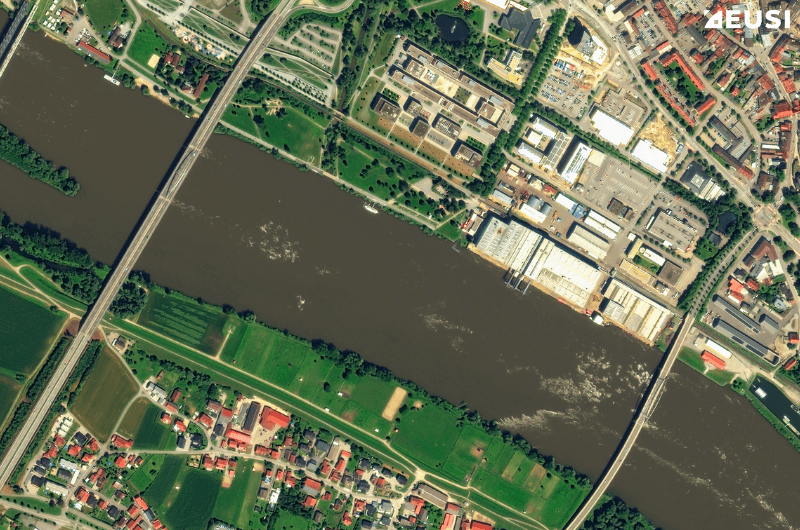
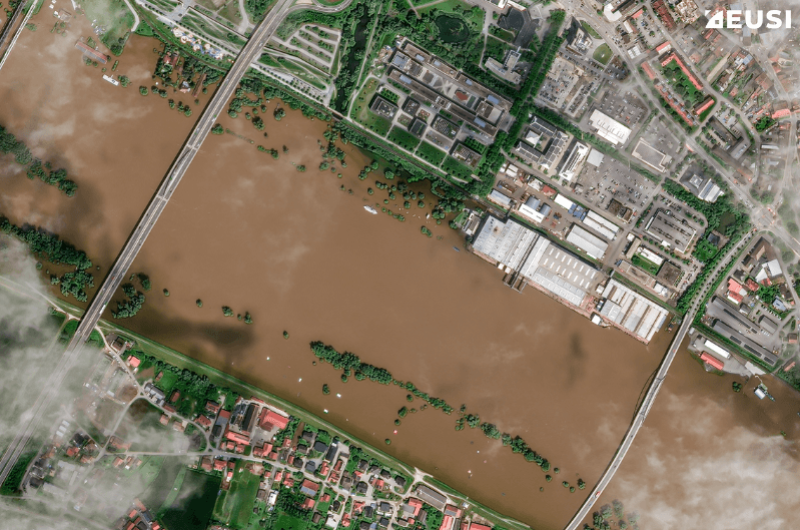
Satellite images show the floods in Deggendorf, Germany. | Satellite imagery © 2024 Maxar Technologies Provided by European Space Imaging
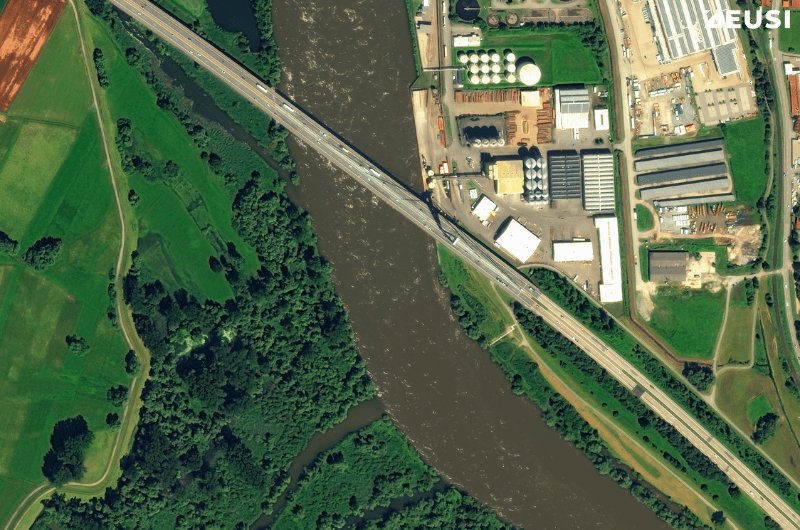
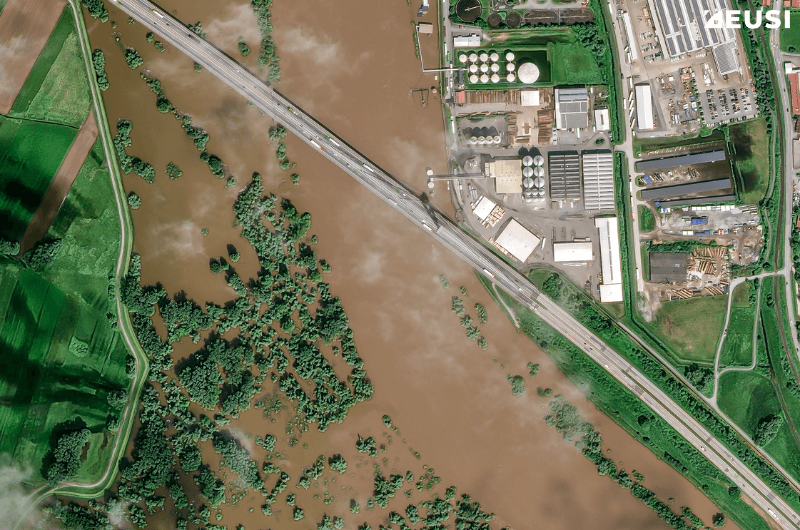
Satellite images show the floods in Deggendorf, Germany. | Satellite imagery © 2024 Maxar Technologies Provided by European Space Imaging
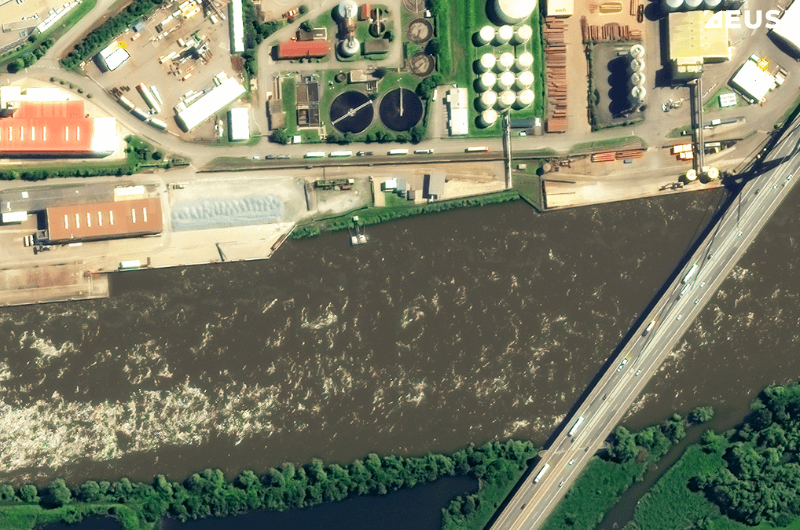
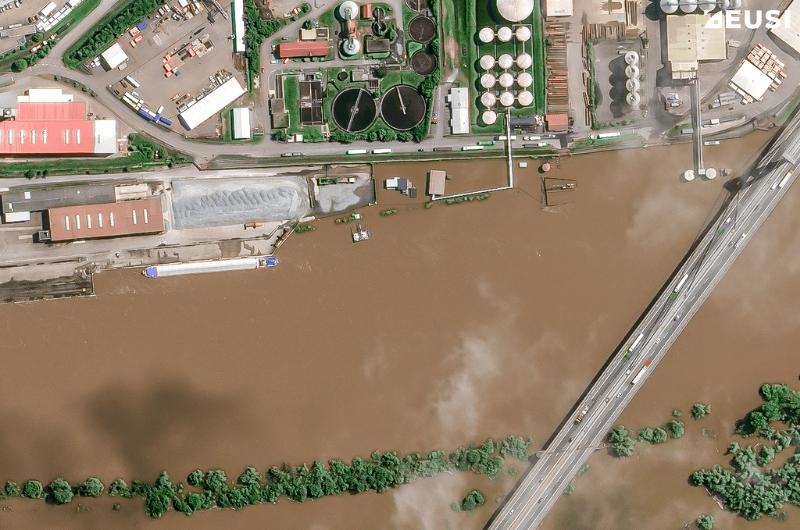
Satellite images show the floods in Deggendorf, Germany. | Satellite imagery © 2024 Maxar Technologies Provided by European Space Imaging
Initially, the region was covered by clouds and the collection of optical imagery was challenging. The analysts from the Indicator Monitoring for Early Acquisition of Innovative Satellite Sensors in Natural Disasters (IFAS) project therefore first received high resolution SAR images from the Umbra satellite constellation and created maps detailing flooded areas. Several days later, we delivered optical imagery which was also used for analysis. The results were made available to authorities and relief organisations such as the Bavarian Red Cross (BRK) and the German Federal Agency for Technical Relief (THW).
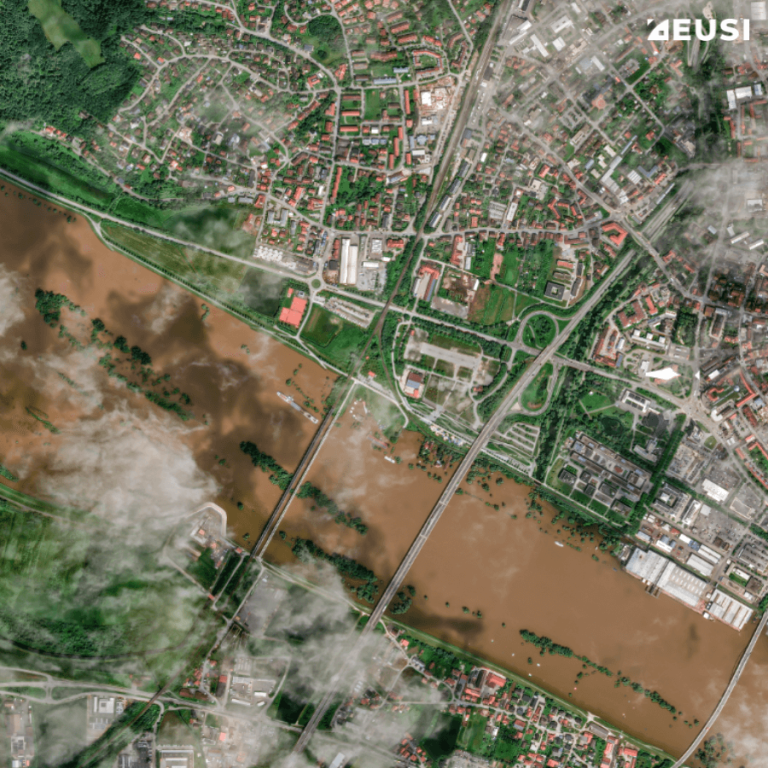
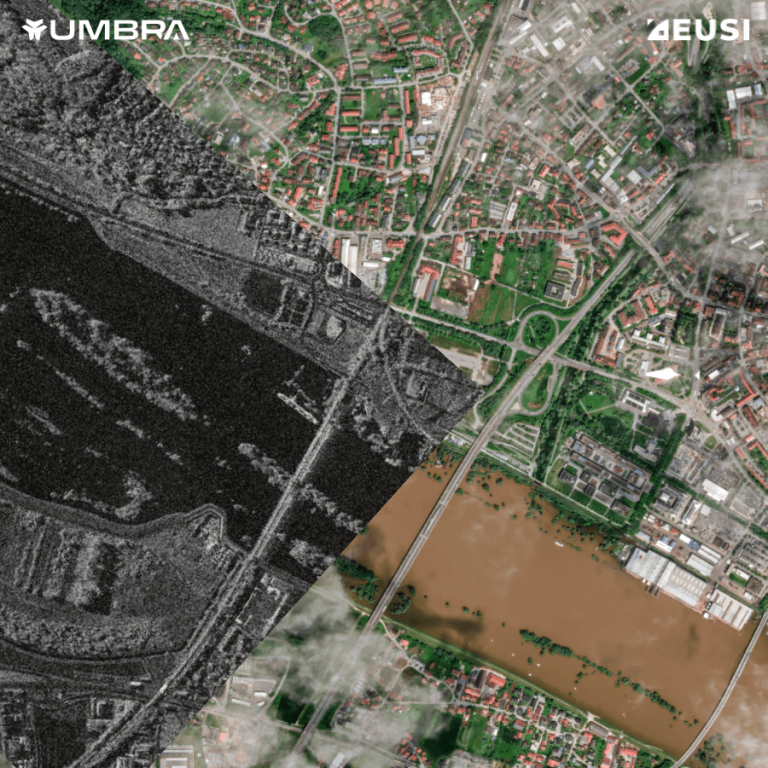
Floods in Greece 2023
In September 2023, entire villages in central Greece were under water. Thousands of households were left without running water and electricity, and according to Copernicus, the flash floods caused damage to over 700 km2 in Greece’s central farming belt. Upon the activation by Copernicus EMS on behalf of the Greek General Secretariat for Civil Protection, we collected the affected areas – including Koskinas, Metamorfosi, Triada, and flooded fields which you can see in the images below.
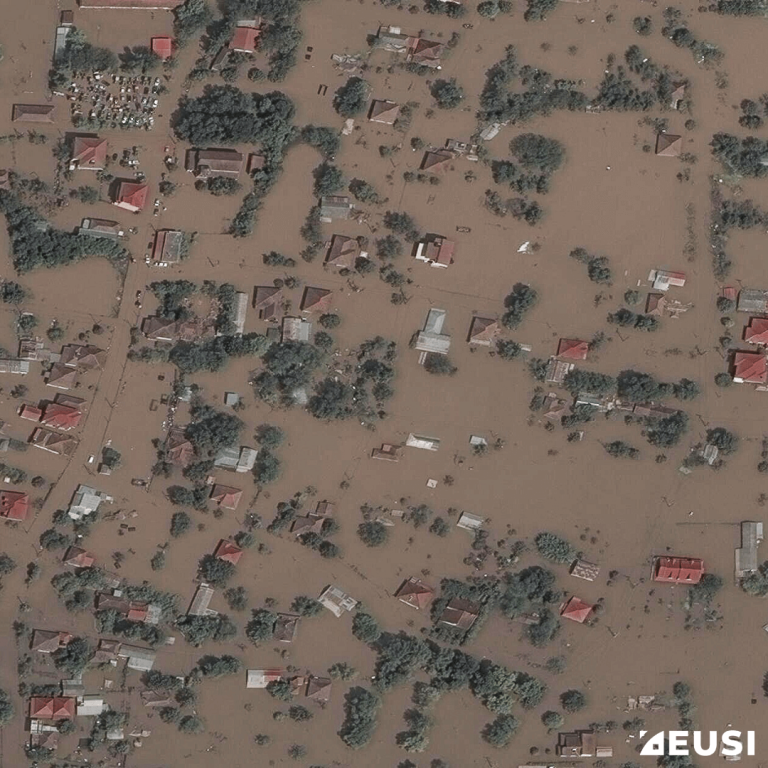
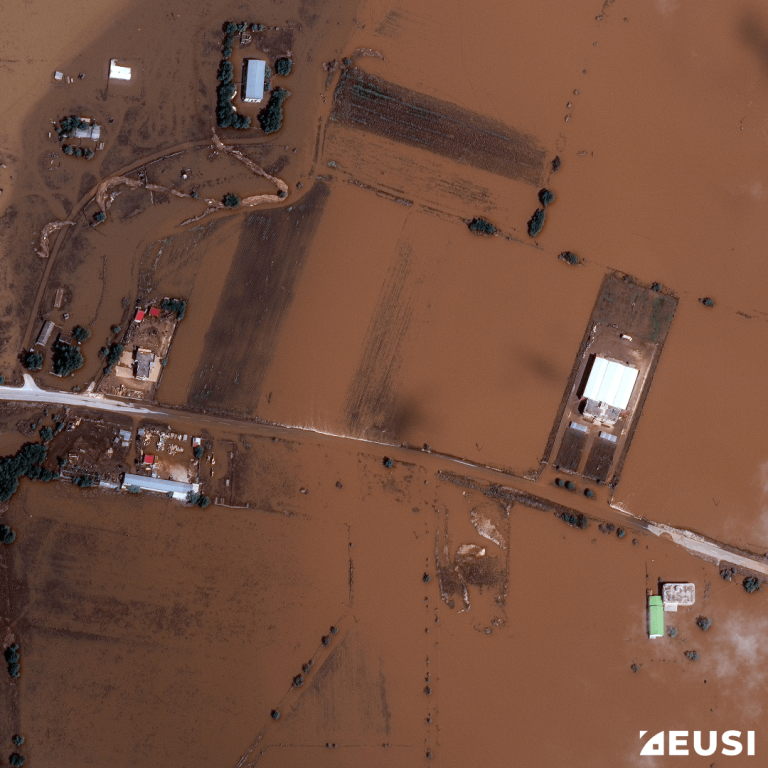
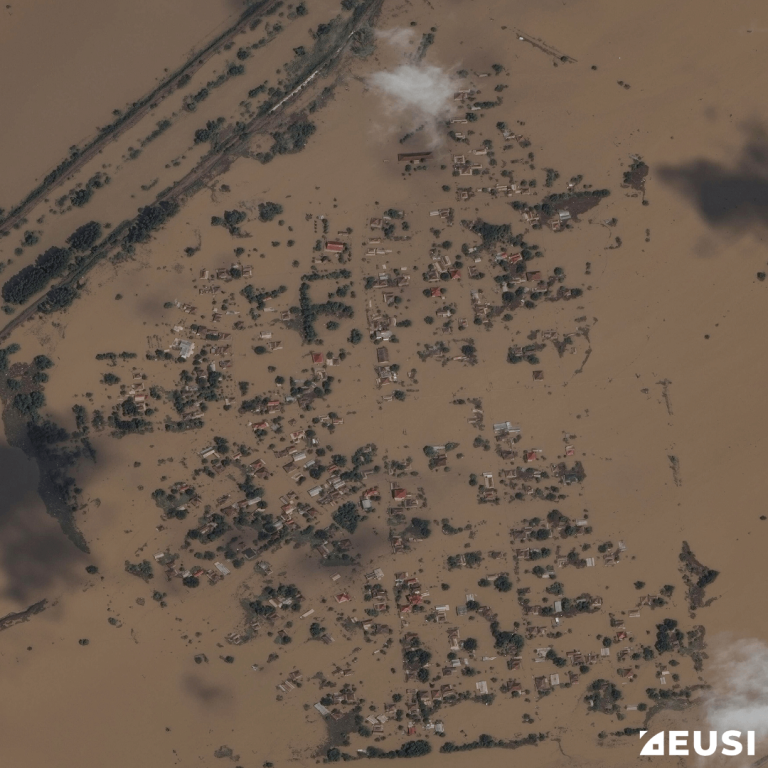
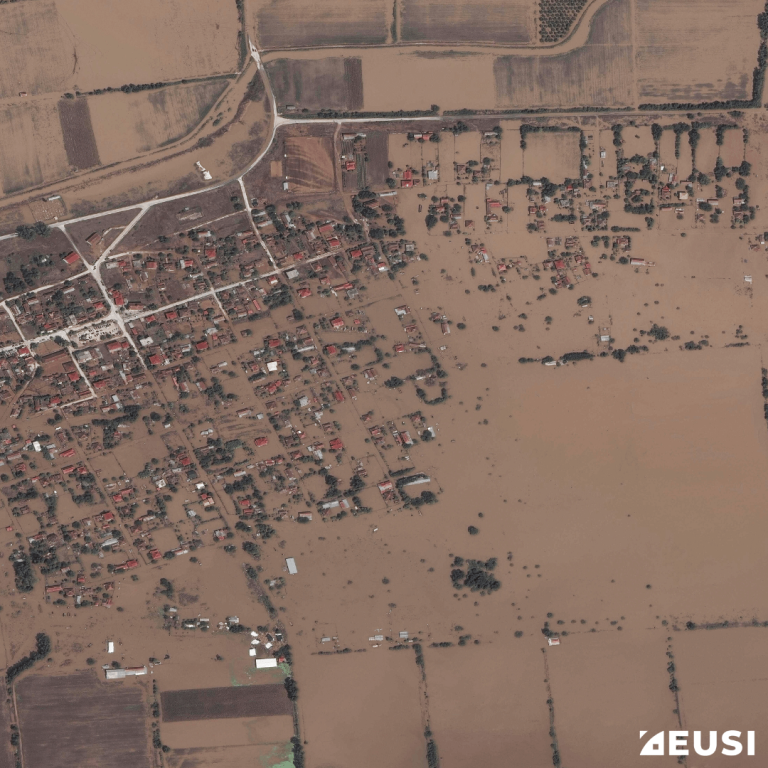
Collapsed dam in Libya 2023
Massive flash floods hit the city of Derna in Libya after two dams had collapsed in September 2023. The water swept away major bridges and most access roads, and entire neighbourhoods were dragged into the sea. We were activated by Copernicus EMS for flood delineation and damage assessment emergency mapping.
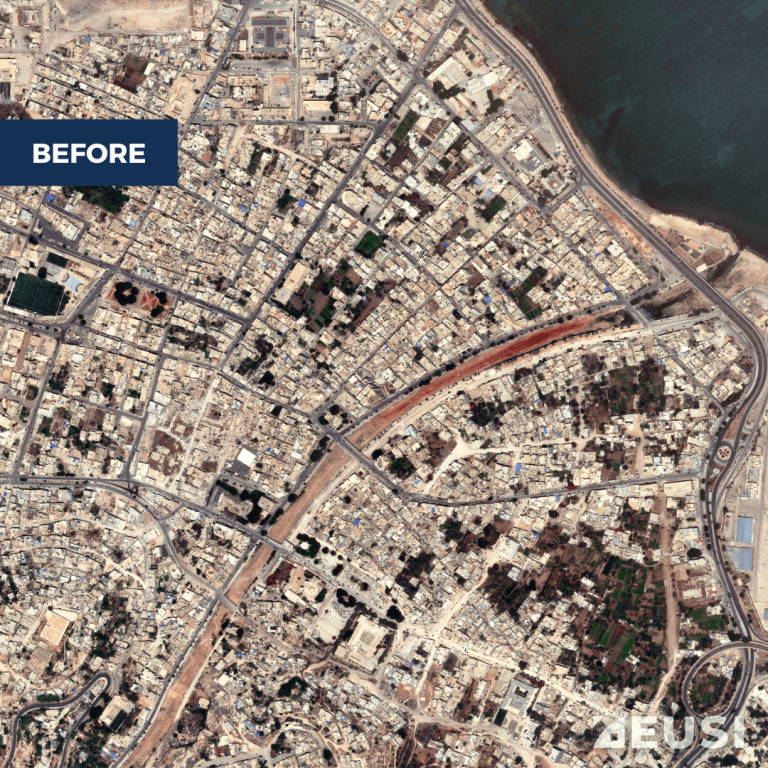
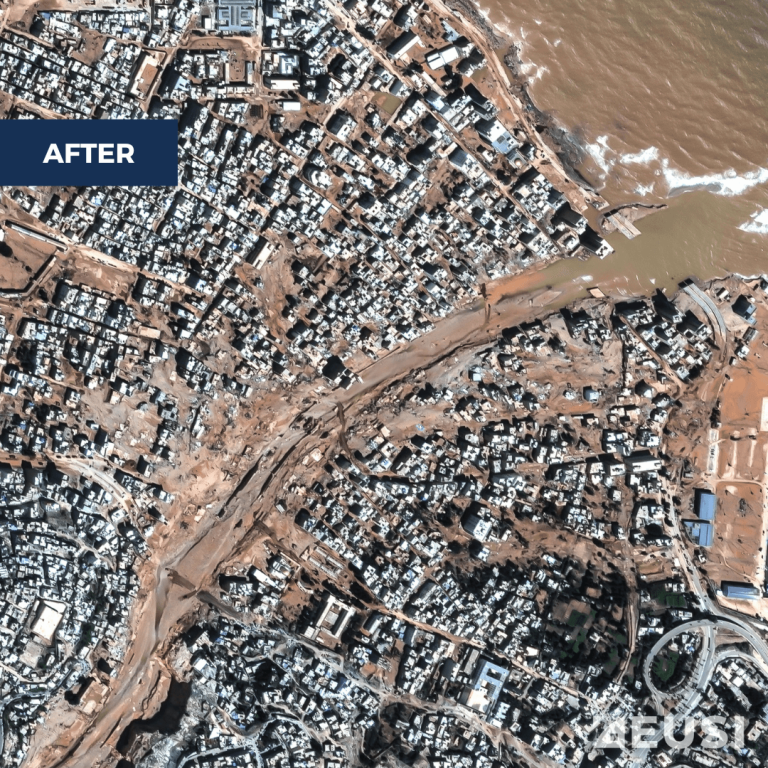
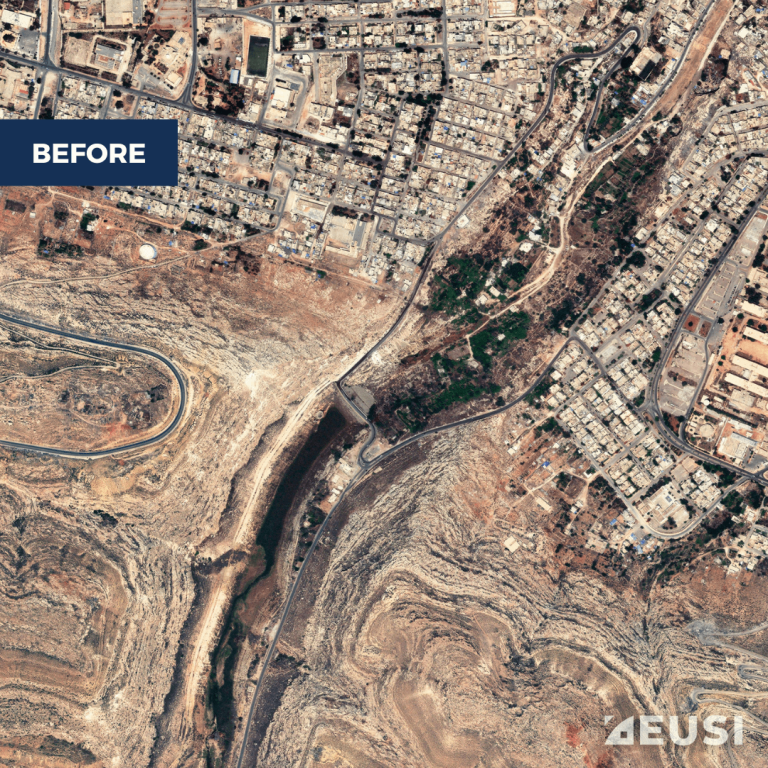
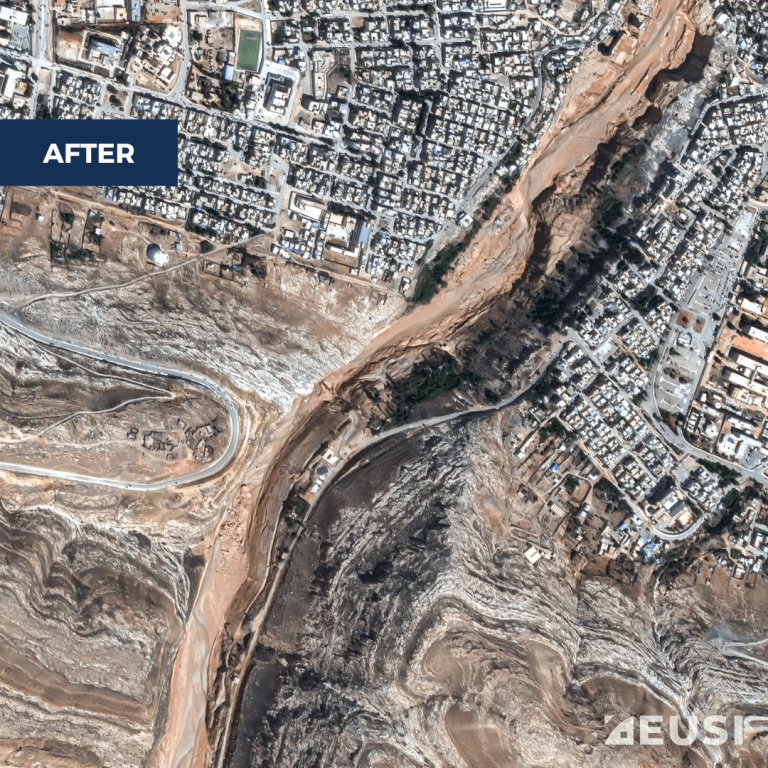
Wildfires
Hundreds of thousands of hectares burn down in Europe and North Africa every year. The average number of fires per year is shocking, especially in southern countries:
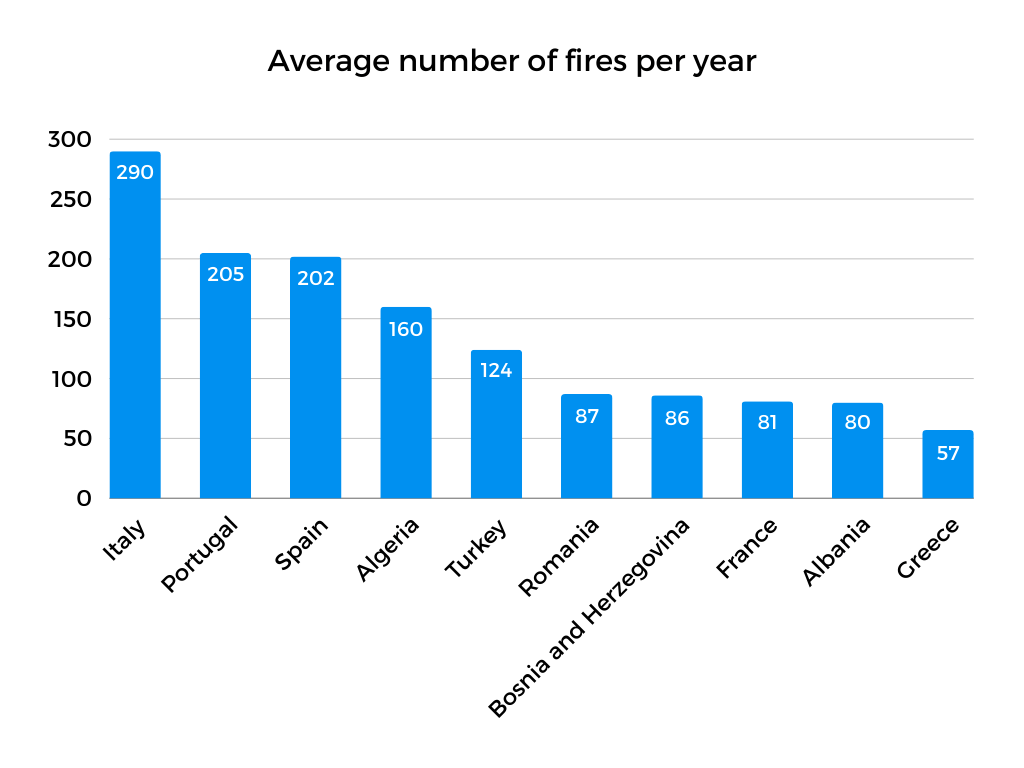
The statistics are based on the data from the years 2006–2023. Source: EFFIS
Unfortunately, wildfires can be difficult to map from above, as they are accompanied by smoke and it’s hard to see anything from a plane. In some cases, sending aircraft can be even dangerous. Satellite imagery, on the other hand, can monitor fires from a safe distance, yet with an incredible amount of detail. Moreover, using a sensor with multispectral bands improves the visibility of the image because it can penetrate through the smoke to a certain degree, and enables relief organisations to better identify which areas are still burning or where vegetation is burnt.
Multispectral imagery for the wildfires in France 2024
A wildfire broke out in Vidauban, a commune at the Cote d’Azur in France, in June 2024. We monitored the situation and collected multispectral imagery in order to aid emergency responders. In the false colour images, using the NIR1, red and green bands, you can see the clear distinction between healthy (red) and burnt (grey) vegetation. Compared to true colour or lower resolution satellite images, the 30 cm multispectral imagery enables very detailed damage analysis, as it provides enough detail to identify individual plants, assess the damage to buildings, and see exactly which structures were affected.
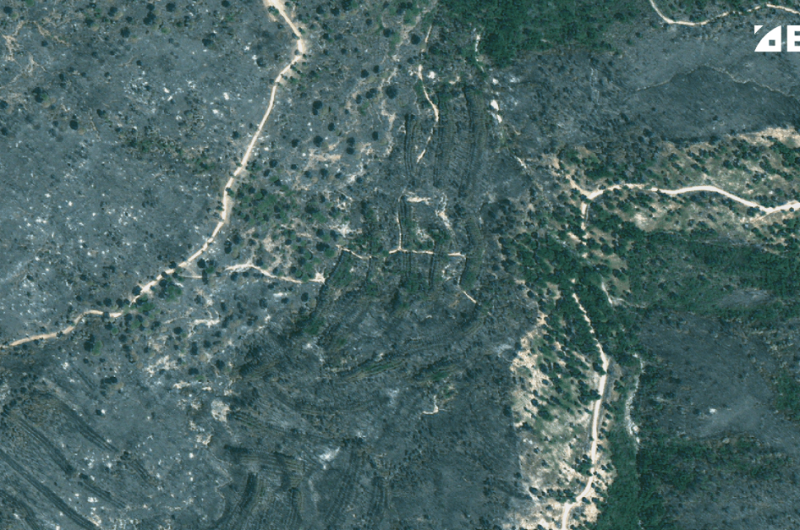
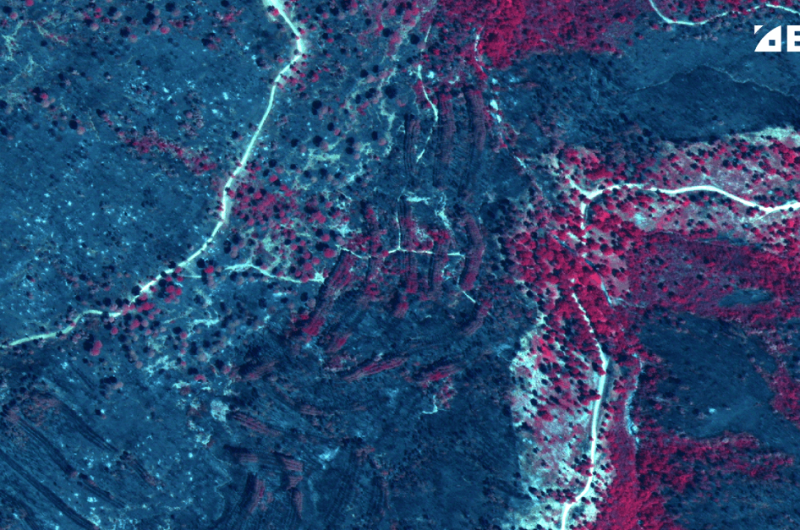
True colour vs multispectral satellite image of burnt vegetation in Vidauban, France. | Satellite imagery © 2024 Maxar Technologies Provided by European Space Imaging
Rapid delivery for the wildfires in Portugal 2019
When multiple fires began on 20 July 2019 near Castelo Branco in Portugal, the Copernicus EMS on behalf of Portugal’s National Command for Relief Operations placed an emergency satellite imagery tasking order with EUSI just after midnight and received the first available satellite collected images in the morning. Thanks to the fast collection, maps that were essential to the firefighting and evacuation efforts were delivered and utilised within hours.
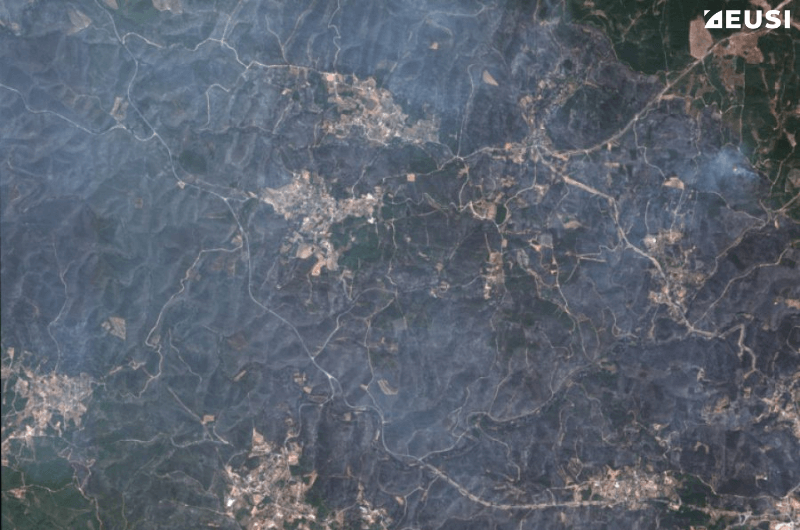
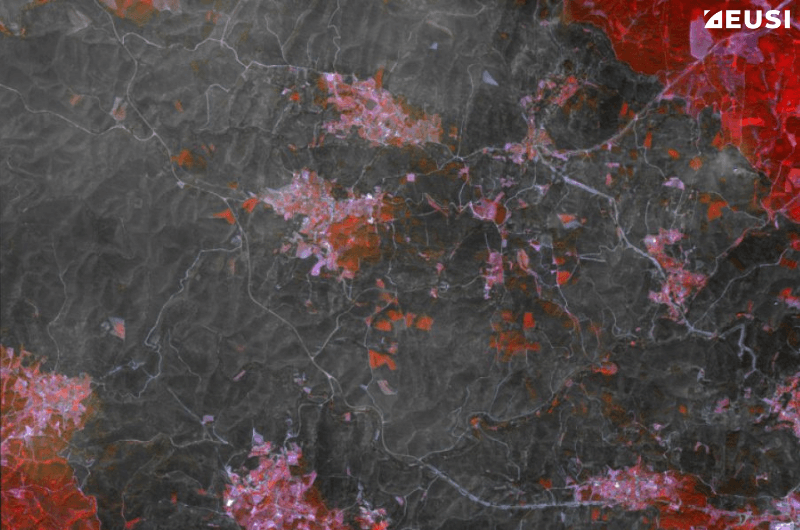
True colour vs false colour (multispectral) satellite image of an area within the wildfire. In the multispectral image, red denotes healthy vegetation while the black/grey areas are burnt vegetation. The distinction is much clearer than in the natural colour images. | Satellite imagery © 2024 Maxar Technologies Provided by European Space Imaging
Damage analysis after a fire in Moria, Greece 2020
Nearly 13,000 people were left without shelter after the fires burnt down most of the Moria Camp on the island of Lesbos in September 2020. In the images below, you can compare the refugee camp before and after the disaster.
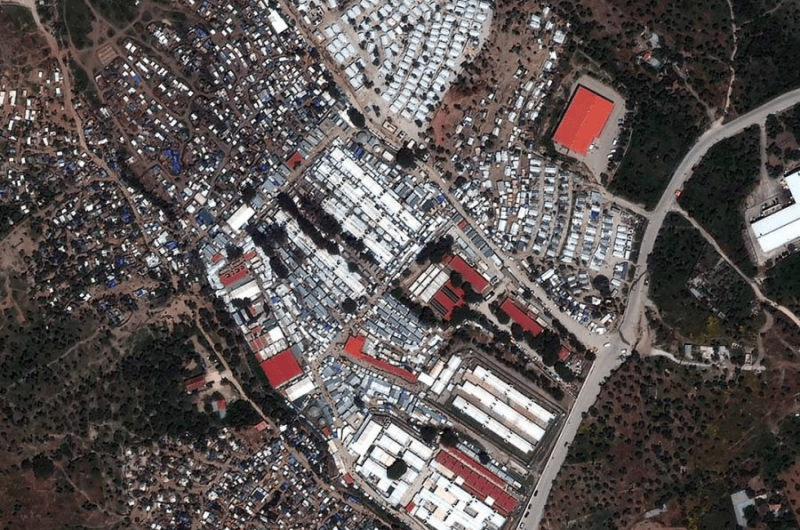
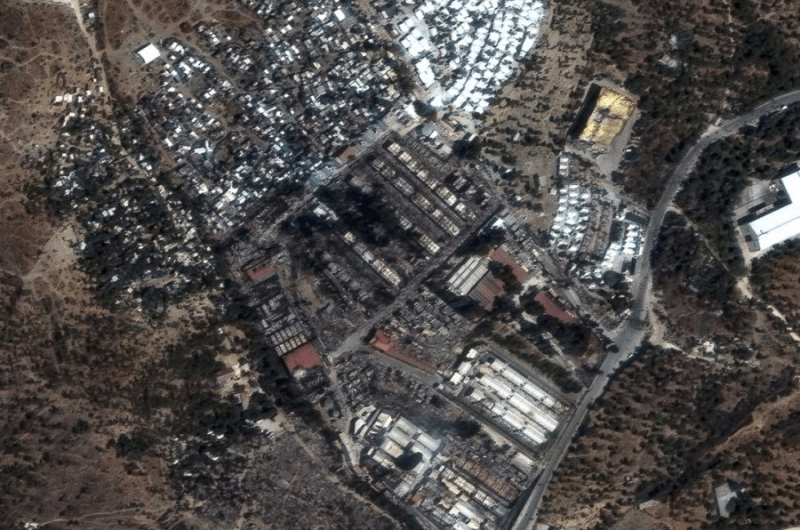
Damage after a fire in Moria, Greece. | Satellite imagery © 2024 Maxar Technologies Provided by European Space Imaging
Landslides
Landslides usually happen in areas that are hard to access; the fact that satellites are in no way restricted by terrain is therefore a major advantage. Not only are they valuable for post-event analysis, very high resolution imagery can also detect landslide risk factors such as:
- water content in vegetation
- moisture patterns
- open erosion areas
- soil composition
Thanks to revealing these risks, satellite imagery has become a valuable tool for generating landslide hazard maps. To document and gain existing and new knowledge about areas prone to landslides, these maps are crucial – and in some cases even legally required.
Creating hazard information maps in Germany 2022
Niklas Heiss from the Department of Geography at the Ludwig Maximilian University of Munich researched the use of different remote sensing data and techniques for creating hazard maps. He used Digital Terrain Models (DTM) with 1 m resolution, aerial imagery with 20 cm resolution, satellite imagery from Sentinel-2 (10 m) and WorldView-2 (50 cm), and vegetation indices like NDVI and NDII calculated from the satellite data. He concluded that the very high resolution imagery (50 cm collected by WorldView-2) was the most effective method for localising small-scale landslides. DTMs helped identify geomorphological features like gullies, debris flows, and creep movements, and field surveys validated the remote sensing analysis and mapped slope dynamics.
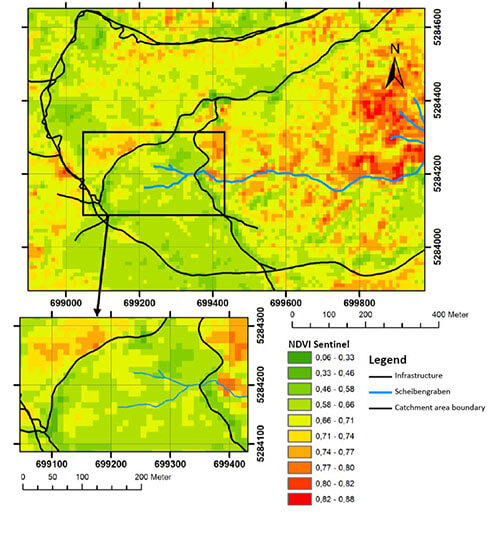
Heiss, Niklas: Possibilities and limits of using remote sensing data for monitoring mass movements in the Bavarian Alps using the example Fockenstein (Mangfallgebirge).
SAR images of the landslide in Turkey 2024
After the landslide at the Copler gold mine near Erzincan, Turkey in February 2024, conditions were too cloudy to collect usable optical imagery. Thankfully, DoubleShot (the combination of Optical and SAR tasking) allowed us to deliver crucial insights to first responders.
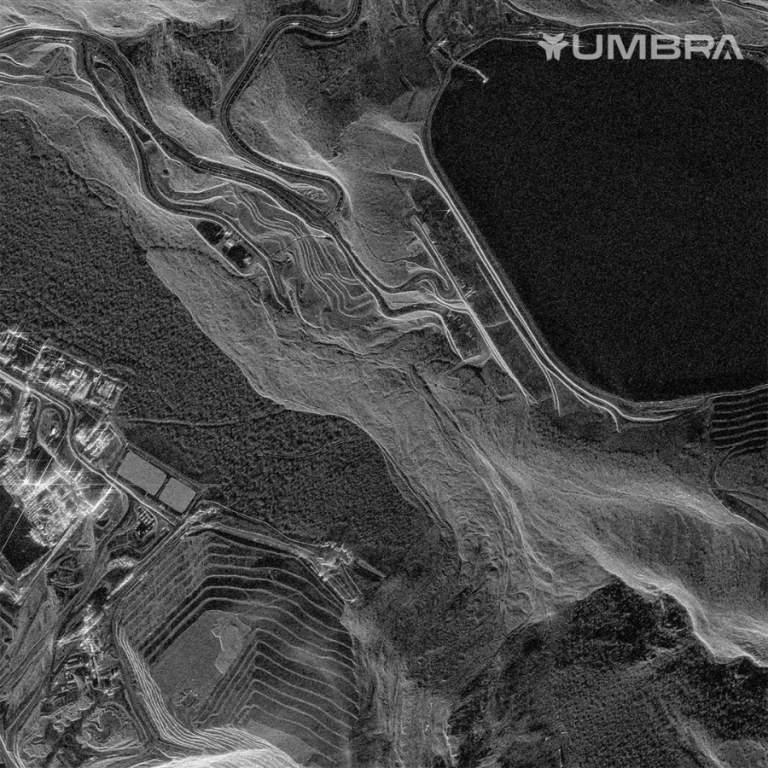
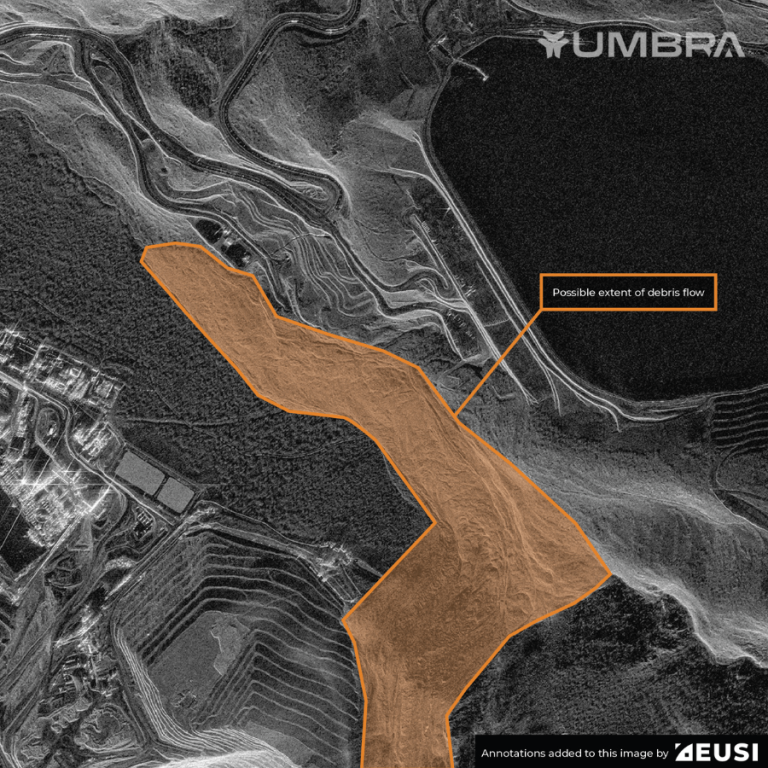
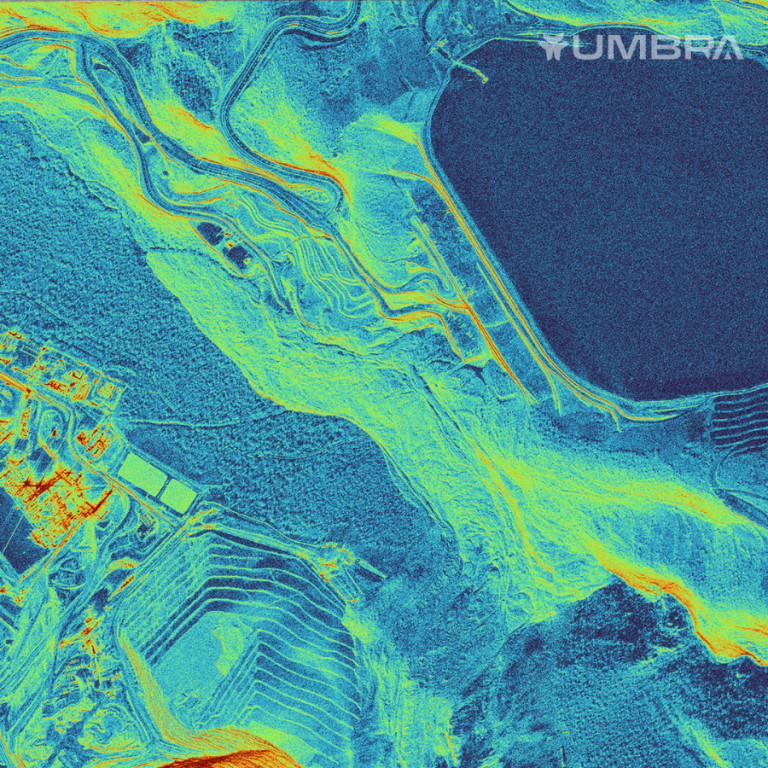
Satellite images revealed drinking water damage after landslides in Germany 2019
After two landslides in Saxony, Germany, EUSI was activated by the Copernicus EMS to supply VHR satellite images at 50 cm in order to assess possible effects on drinking water infrastructure in the area. The map showed that the landslides had blocked a tunnel connecting two water reservoirs, potentially having a severe impact on drinking water in the Berlin area.
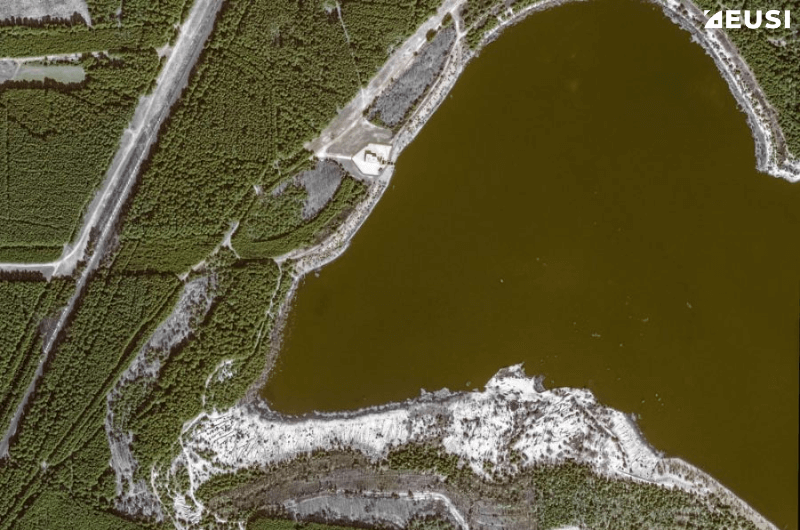
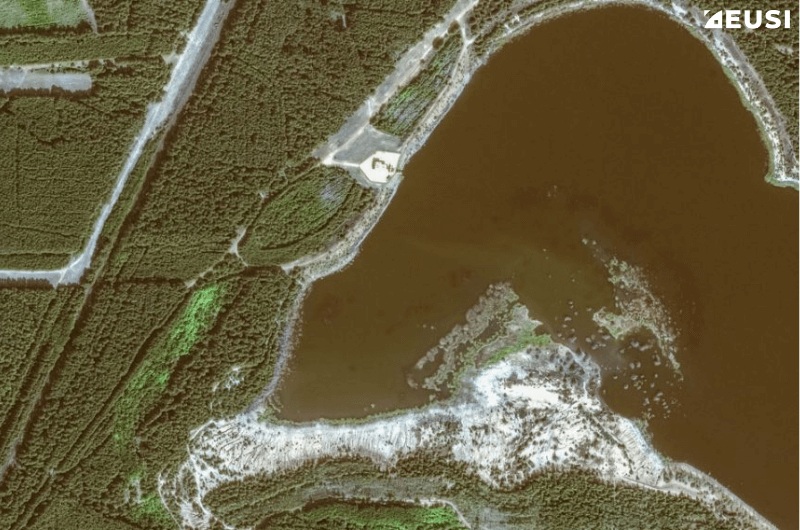
Before and after the landslide in Saxony, Germany | Satellite imagery © 2024 Maxar Technologies Provided by European Space Imaging
Earthquakes
Over 1,200 active faults (underground tectonic ruptures) have been mapped in Europe, covering more than 90,000 km and causing about 130,000 earthquakes every year (according to EFEHR and Volcano Discovery). Satellite images are used by first responders and relief organisations to quickly assess damage, plan mitigation measures and monitor reconstruction.
Earthquake in Turkey and Syria 2023
A destructive earthquake at a magnitude of 7.8 struck Turkey and Syria in February 2023. We collected satellite imagery showing the aftermath in the cities of Islahiye, Nurdagi and Antakya. The images clearly show collapsed buildings and temporary shelters, and help convey the intensity of the disaster.
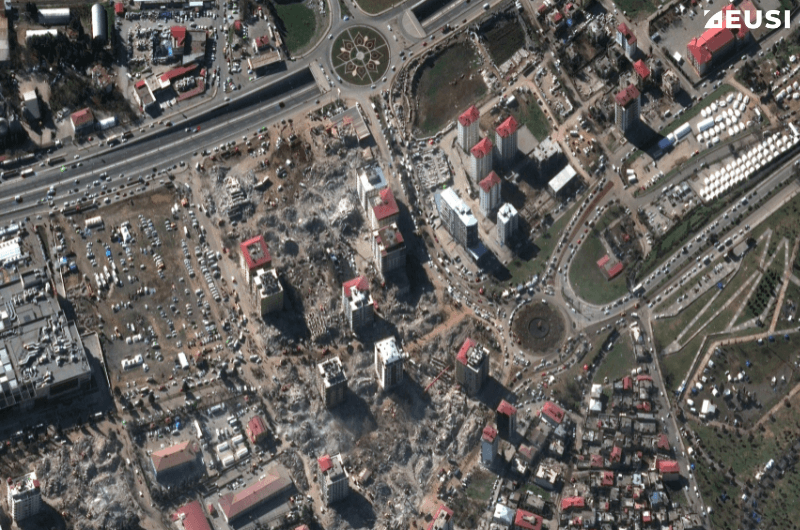
Damage to buildings after Turkey and Syria were hit by a magnitude 7.8 earthquake. | Satellite imagery © 2024 Maxar Technologies Provided by European Space Imaging
Damage after the earthquake in Morocco 2023
A 6.8 magnitude earthquake that struck Morocco in September 2023 was the strongest and deadliest in the country’s modern history. We collected imagery over the affected areas, revealing the damage and ongoing rescue operations.
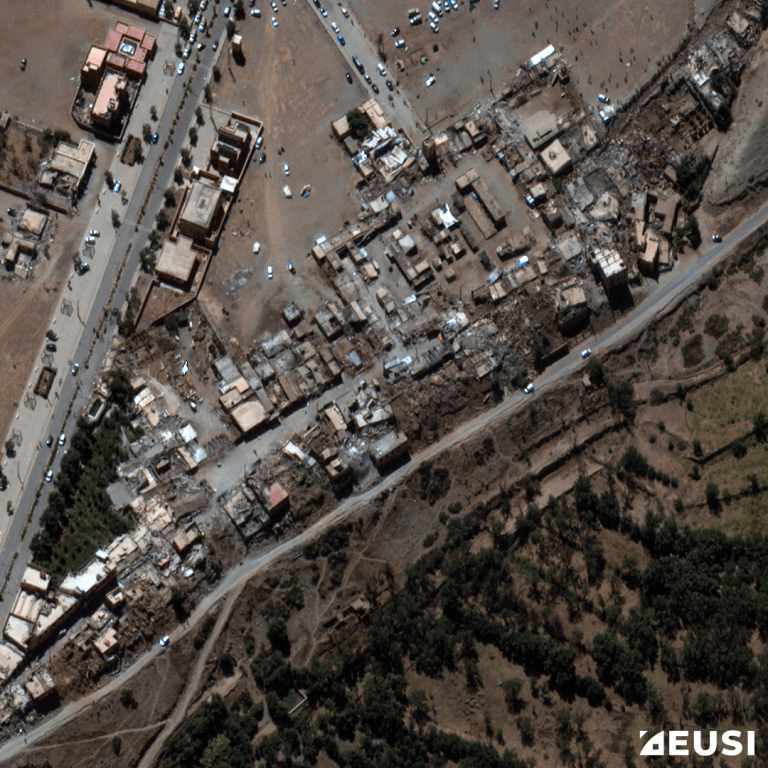
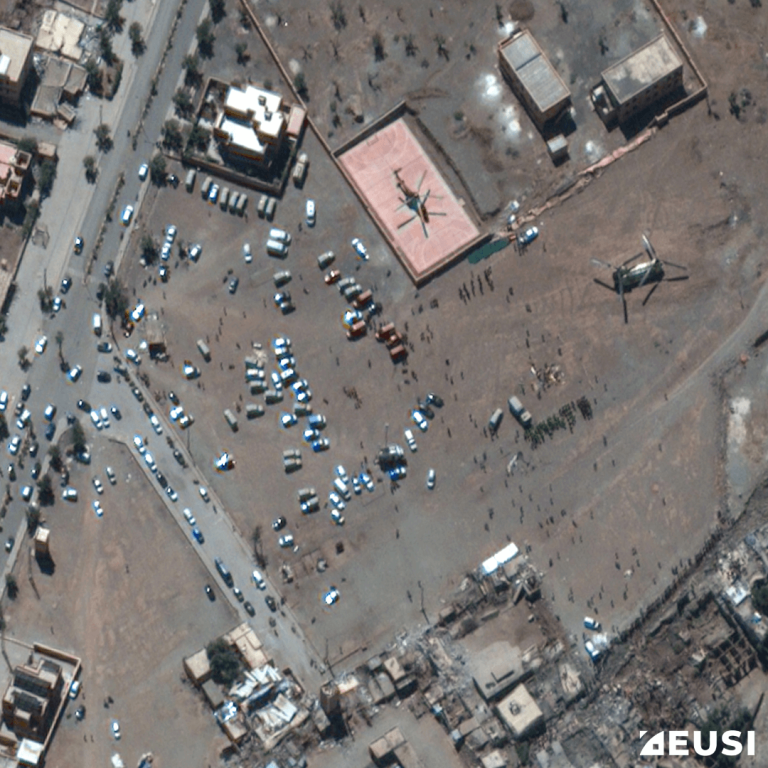
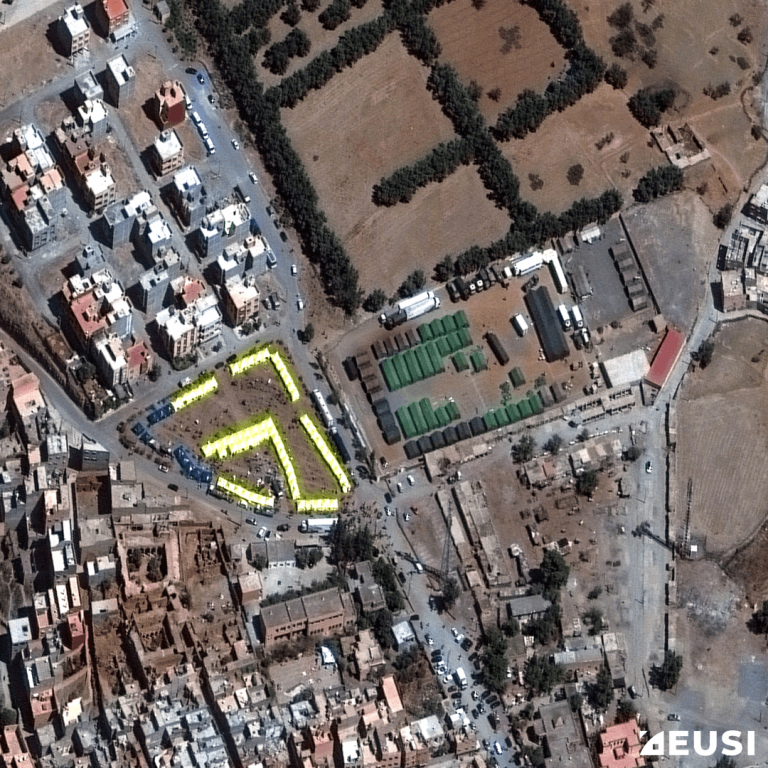
Delivering imagery after the earthquake in Italy 2016
When a 6.2 magnitude earthquake hit Italy in August 2016, we and our partner Planetek Italia immediately started working on collections to support disaster relief efforts by supplying the first available VHR satellite imagery to emergency management services and the media just hours after the disaster. The imagery, captured by the WorldView-2 satellite at 40 cm resolution, was provided to the Humanitarian OpenStreetMap Team (HOT) and was made available to volunteers, who were contributing to the damage detection and mapping. This activity provided updated information to institutions and emergency services during the emergency and after.
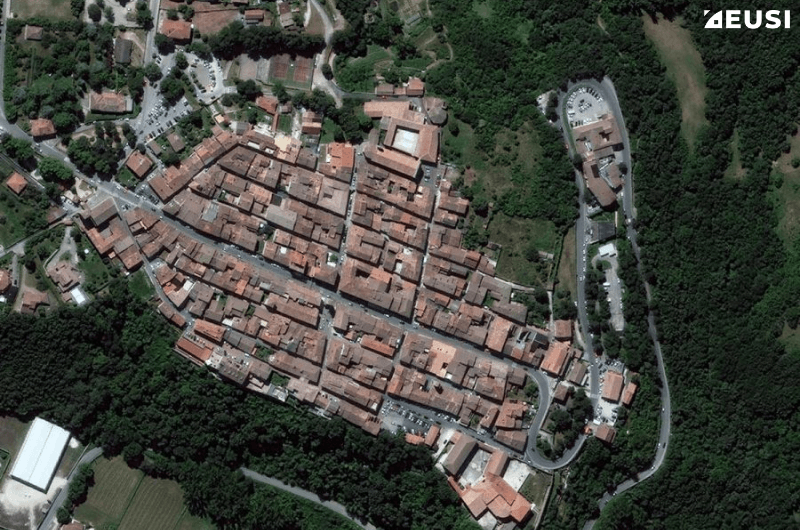
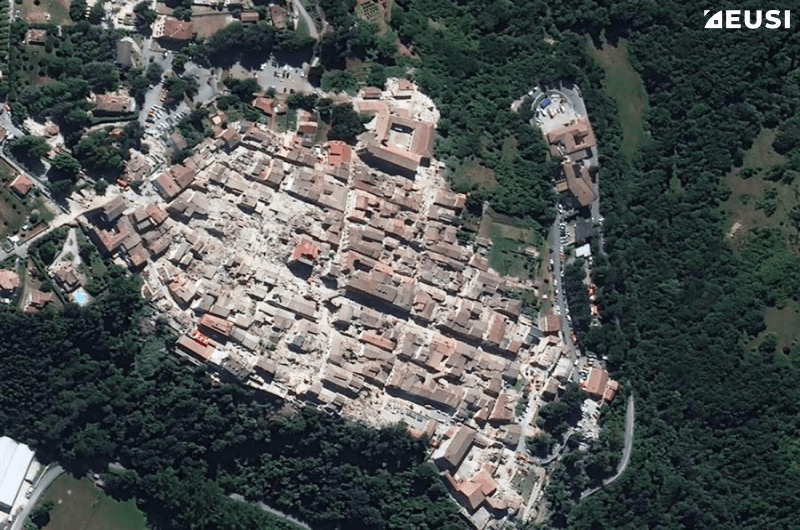
Damages in Italy after being struck by a magnitude 6.2 earthquake | Satellite imagery © 2024 Maxar Technologies Provided by European Space Imaging
Other disasters
Satellite images have proven helpful in other types of emergencies as well, including volcano eruptions, explosions, tornadoes, hurricanes, or active conflict zones.
Volcano eruptions in Iceland 2023–2024
Several volcano eruptions have occurred in Iceland in recent years. In the images from July 2023, fire is clearly visible. The image from January 2024 shows the lava flows that caused damage to the town of Grindavik.
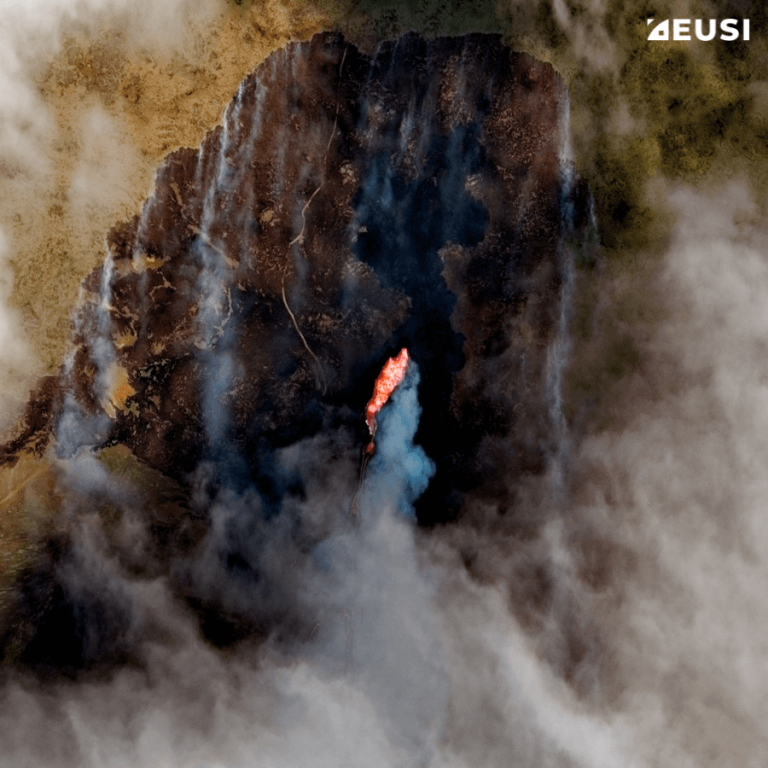
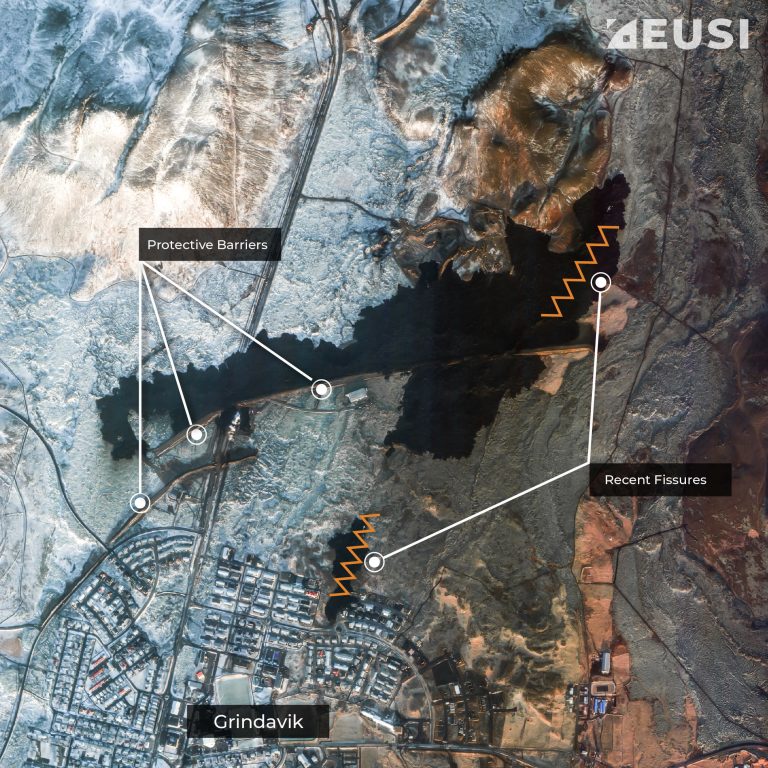
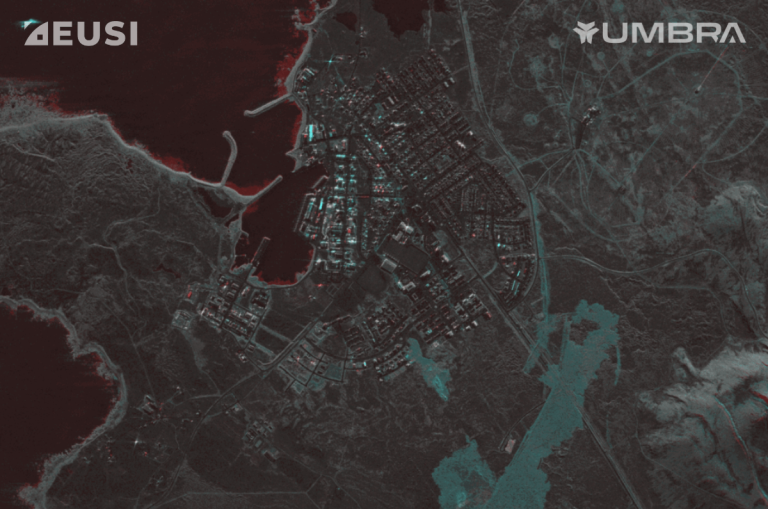
Explosion in Beirut 2020
In August 2020, the explosion at the Port of Beirut caused at least 200 deaths, 6,000 injuries, and 14 billion Euros in property damage. We provided post-event imagery which was used for damage assessment by means of visual interpretation. The estimated geometric accuracy of the resulting damage map (RMSE) was 1 m or better.
Free emergency mapping services: Introducing Copernicus EMS
Most emergency related imagery that we collect is ordered by and delivered to the Copernicus Emergency Management Service (EMS). This EU programme uses satellite imagery and other geospatial data to provide eligible users with free-of-charge mapping service in the case of natural disasters, human-made emergency situations and humanitarian crises throughout the world. As soon as an emergency occurs, Copernicus EMS activates EUSI and other data providers. We then collect at the first possible opportunity (taking needed resolution, Off Nadir Angle, weather, and required parameters into account) and rapidly deliver the imagery to the Copernicus EMS, who then generate disaster extent and damage maps from the imagery and make both available to first responders and relief organisations. The maps are published on the EMS website and can be used by the general public as well.
Copernicus EMS provides mapping during all phases of the emergency management cycle and always free of charge for the eligible users. The maps are produced in two temporal modes:
- Rapid Mapping provides geospatial information only hours or a few days after the activation to support emergency management activities immediately following a disaster.
- Risk & Recovery Mapping consists of the on-demand provision of geospatial information to support disaster management activities not related to immediate response.
We are proud to be part of these services, and we are doing our best to rapidly deliver the highest quality satellite images with the potential to save lives. If you have any further questions or want to order satellite imagery, don’t hesitate to contact us at info@eupaceimaging.com.
Key takeaways
Satellite imagery can help:
- Before emergencies: predict and prevent certain disasters, especially wildfires, floods, and landslides, and prepare for emergencies, for example by planning evacuation routes
- During emergencies: create maps, determine resource allocation, consider the status of critical infrastructure, choose suitable evacuation routes, and help the efficient deployment of disaster response teams
- After emergencies: analyse damage and monitor reconstruction
Benefits of using satellite images for emergency management:
- When a disaster happens, obtaining data quickly is crucial. Thanks to our upgraded ground station in Germany, we are able to deliver imagery up to 15 minutes after collection.
- Satellites can collect large areas in a single image (for example WorldView-2 can collect 15,000 km2).
- In very high resolution imagery, you can see details like individual plants, power lines or vehicles. We offer a resolution of up to 15 cm HD or 30 cm native for optical imagery, and 25 cm for SAR imagery (through our partner Umbra).
- Satellites have easy access to all areas. They aren’t restricted by terrain or national borders.
- Multispectral imagery allows you to see beyond the capabilities of the human eye – it can show soil composition, plant water content and health, and many other characteristics. We are the only provider on the market who offers 8 multispectral bands at 30 cm resolution (after pansharpening).
- SAR satellite sensors penetrate clouds and smoke, which is particularly valuable for collecting satellite images of floods, wildfires, and other disasters. They can also collect images at night.
How to get access to satellite images for emergency response?
- Copernicus EMS provides rapid mapping and risk & recovery mapping services to eligible users for free. To gain access, reach out to Copernicus.
- If you have questions or want to order satellite imagery for your project, contact us at info@euspaceimaging.com
Related Stories
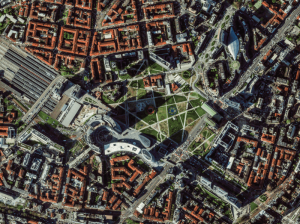
Europe’s Green and Digital Transformations with 25 Years of VHR Satellite Archive Data
Planning Europe’s future without knowing its past is impossible. The European Green Deal, Horizon Europe, the EU Biodiversity Strategy for 2030 and other policies all demand one thing: evidence. Not just today’s data, but years of history that show how our cities, forests, and coastlines have changed.
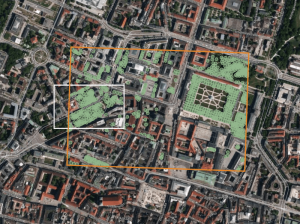
AI Uses 15 cm Satellite Images to Cut Costs and Increase Scalability in Forest Management and Urban Forestry
Forest managers across Europe face an impossible task: monitor millions of hectares with shrinking budgets while meeting increasingly strict EU environmental targets. But with the rise of AI and satellite technology, they now have new solutions at their disposal – smarter, cheaper, and more scalable – to monitor forest health, automate tree inventories, and plan sustainable logging. In this article, we introduce one of these solutions: an AI forestry algorithm developed by Arboair using 15 cm satellite data from EUSI.

GEOSeries: Extracting Insights From High Resolution SAR Imagery for Time-Sensitive Analysis
In this webinar, industry experts and advanced users of Umbra SAR data showcase how they transform SAR imagery into actionable insights in real-world mapping, monitoring and intelligence applications. See how NV5 and Umbra leverage ENVI SAR Essentials for advanced processing with time-efficient results, converting analytics into valuable intelligence.

Using Satellite Imagery to Build Water Resilience Across Europe
Water across Europe is facing severe pressure. Climate change, urbanisation, agricultural demands and other sources of pollution are threatening water security and creating critical challenges that need to be addressed. We have to act quickly, build stronger systems and create sustainable water resilience practices – so that both natural ecosystems and human communities can thrive. Here is how satellite imagery from EUSI can help.





